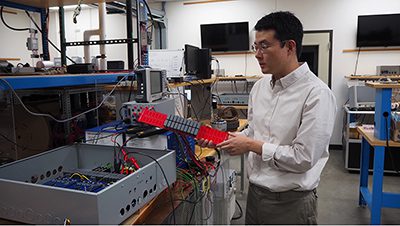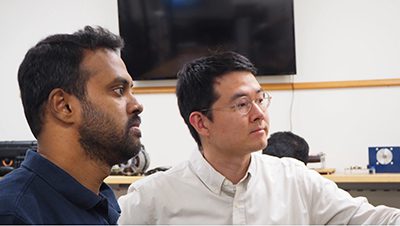Spartans are innovating batteries, electronics, composite materials and more to push electric vehicles farther while training the nation’s future workforce.
Researchers at Michigan State University are building battery packs that will deliver higher voltages and lower currents than what electric vehicles use now. The work provides opportunities for improvements, especially as it dovetails with MSU’s power electronics research.

“Power electronics are like an intermediary between the source of energy and the load that uses the energy,” says Woongkul “Matt” Lee, an assistant professor in the Department of Electrical and Computer Engineering. “So, we want them to be very efficient. We want to produce minimal energy loss during this power conversion process.” Lee also is a faculty member of the Electric Machines and Power Electronics Research, or EMPowER, Laboratory at MSU.
Power electronics ensure that the different systems in a vehicle are getting the electric energy they need in a way they can best use it — with the appropriate voltage and current, for example.
If future vehicle batteries could double the voltage of what’s used in today’s EVs, they could deliver the same amount of power with half the current.
“And power loss is coming from current. If we cut the current by half, the loss is reduced by 75%,” Lee says. “Mathematically, that’s a very easy way to boost efficiency.”
Making the math work in a real vehicle is much more challenging, but it’s a challenge Lee and his team take pride in confronting. They believe that embracing complexity within the confines of power electronics will simplify obstacles elsewhere in the vehicle.
He, and other researchers at MSU, have a body of work that’s gained interest and support from corporate partners to justify that belief. In his lab, for example, he’s got multiple generations of prototypes demonstrating a new architecture his team has developed over the past several years to improve components called inverters.

Inverters live between batteries and motors, converting direct current signals to alternating currents (perhaps a helpful mnemonic device is that inverters go DC to AC, the inverse of the order chosen by the legendary Australian rock group AC/DC).
So, Lee and his team would have been developing this more efficient inverter even before MSU and the U.S. Army announced a new $9 million initiative in July to make electric autonomous vehicles safer, smarter and more dependable. What the new grant is now doing, though, is putting Lee’s work on a table, along with developments from more than a dozen different labs across campus, to work toward a common goal.
“I had never been on this kind of big project before with multiple investigators from different areas,” Lee says. “It’s exciting to see what our colleagues are capable of, and it really inspires new ways of solving problems.”
This collaboration is enabling ideas, like doubling the battery voltage to minimize losses in power electronics, to take flight. Interestingly, and importantly, these ideas are also allowing EVs to shed weight.
EVs are currently much heavier than their counterparts powered by internal combustion engines, meaning they must expend more energy to move a vehicle the same distance.
Innovations like being able to operate at lower currents would mean manufacturers could use thinner, lighter wires. And more efficient inverters can operate with fewer hefty components.
Even dropping a few grams from batteries would add up. Despite coming in a single package, car batteries are currently made up of thousands of individual cells, about the size of C batteries, wired together.
There’s lots more to see in a science story written by Matt Davenport, “MSU is working to solve range anxiety,” courtesy of MSUToday.
About the MSU Innovation Center:
The MSU Innovation Center is dedicated to fostering innovation, research commercialization, and entrepreneurial activities from the research and discovery happening across our campus every day. We act as the primary interface for researchers aiming to see their research applied to solving real-world problems and making the world a better place to live. We aim to empower faculty, researchers, and students within our community of scholars by providing them with the knowledge, skills, and opportunities to bring their discoveries to the forefront. Through strategic collaborations with the private sector, we aim to amplify the impact of faculty research and drive economic growth while positively impacting society. We foster mutually beneficial, long-term relationships with the private sector through corporate-sponsored research collaborations, technology licensing discussions, and support for faculty entrepreneurs to support the establishment of startup companies.
Is your company interested in powering future engineering research at MSU? Click Here.
